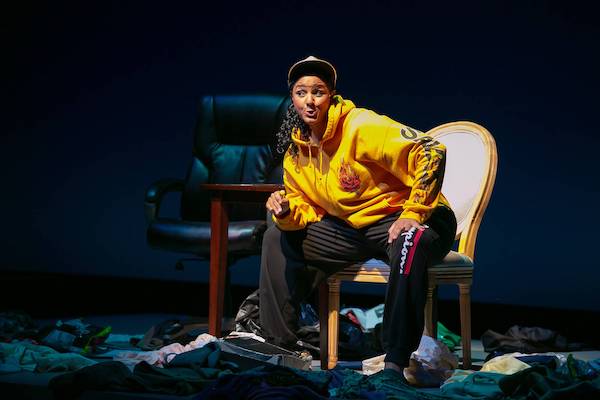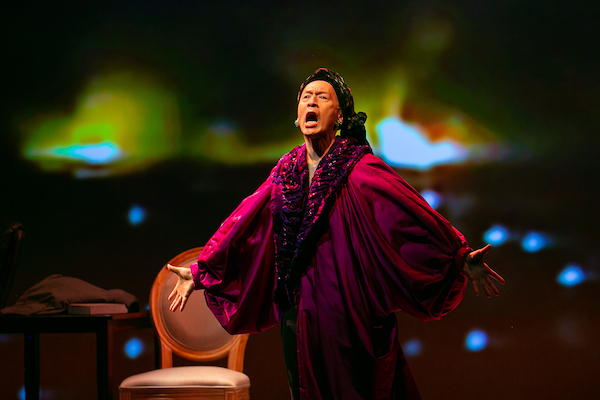Theater Review: “Twilight: Los Angeles, 1992” — “Plus ça change, plus c’est la même chose”
By Mark Favermann
Anna Deveare Smith’s examination of racism in America remains powerful, 30 years on.
Twilight: Los Angeles, 1992, written and revised by Anna Deavere Smith. Directed by Taibi Magar. Scenic Design by Riccardo Hernandez. Costume design by Linda Cho. Lighting design by Alan C. Edwards. Sound design by Darron L West. Projection design by David Bengali. Presented by American Repertory Theater in association with Signature Theatre at the Loeb Drama Center, Cambridge, through Sept. 24.

Tiffany Rachelle Stewart as Katie Miller in Twilight: Los Angeles, 1992. Photo: Lauren Miller
What do you say about a theatrical experience that is moving, at times poignant, but more than a little repellent? Theatrically, the experience is marvelous on all levels, from the superb performers to the trenchant script. The stagecraft is stunning, at times visually breathtaking. But who is the audience, now, for playwright/performer Anna Deavere Smith’s 1992 examination of racism in America? After three decades, don’t we know the score? In the aftermath of George Floyd’s senseless murder by a Minneapolis policeman and the rise of the Black Lives Matter movement? What is the point of this tour-de-force — except to preach to the choir?
Smith is aware of the irony (or would that be stasis?) and has revised her play to commingle the present and the past in a brilliant, but sad, reflection on 30 years. She first developed the script to dramatize the racial fault lines revealed by Rodney King’s brutal beating by several Los Angeles cops, an act of videotaped police brutality that triggered the highly destructive LA riots. The stunning news of the police officers’ acquittal threw the streets of Los Angeles into turmoil, riots that drew worldwide attention. Smith’s then innovative approach was to transcribe and edit material from hundreds of interviews she conducted with witnesses and participants after the events. Initially, all the parts were played by Smith — many critics found it to be a pyrotechnical marathon of a one-person show.
Smith’s original exploration was a stirring cry for reform, an attempt to dissect the causes of civil unrest through the clashing perspectives presented by an eccentric range of personalities: the famous and the infamous, the political and the marginal. The result was a forceful confrontation with a complicated truth. Presumably, Smith’s hope is that this new version of Twilight: Los Angeles, 1992 will help move the needle in our current traumatic predicament.

Francis Jue as Jessye Norman in Twilight: Los Angeles, 1992.
Smith revised the play last year for a cast of five while in residence at Signature Theatre in New York City. Taibi Magar directed that production and she is also at the helm of this eloquent Cambridge staging. The 2022 version has been revised for an ensemble whose members play a myriad of characters. The revision goes out of its way to underline the links between today’s prejudices and those of 1992. But over the decades the public conversation has degenerated radically; one of our two major political parties is reluctant to condemn white supremacy! Because the piece has been shaped to appeal to the racially and socially enlightened, this rejiggered Twilight: Los Angeles, 1992 lacks appropriate agency: it is not aimed at those who would best be challenged by it.
The staging is superb, framed so that we can follow the trajectory of each character, whose name and description appears in headlines on screens above them, screens that are also used to show documentary film and video footage. Tiffany Rachelle Stewart is a standout in a variety of roles, including Elvira Evers, Maxine Waters, a rather clueless sorority coed, and Juror #7. Francis Jue effortlessly transforms from female to male characters of various ages: he portrays, among others, individuals from the Korean community, an academic, an opera diva, and a minister. Carl Palmer plays all the middle-aged and older white male parts. His characters jump between bombast and guilt, entitlement and shame, arrogance and embarrassment. He maneuvers adroitly through the various shades of whiteness. Wesley T. Jones plays each of the Black male characters with dignity, resignation, and cynicism. He also taps into their inner rage. Elena Hurst’s ethnic quick-change artistry amazes — her gender-bending portraits are as powerful as they are provocative.

Wesley T. Jones as Charles Lloyd in Twilight: Los Angeles, 1992.
The production’s stagecraft — settings, use of space, lighting, video projections, etc. — are impressive, seamlessly underscoring a narrative that, though propelled by soliloquies, is often intense. Still, that vitality flags. Act 1 is about 20 minutes or so too long, while Act 2 also feels overextended. Smith’s heavy doses of verbosity undercut the wizardly theatricality — the experience is exhausting rather than electrifying. In addition, the “dinner party” device of Act 2, an attempt to connect with the bedeviled present, comes off as an inauthentic swerve from reality. An easy celebration of progressive politics (California brand) prevails over what might have been a serious confrontation with the current death match between America’s red and blue states. Our politics are far more paralyzed than Smith seems willing to admit. Those who believe in social justice (the choir) will be satisfied. But the biased as well as the pious and everyone in between will be justifiably frustrated. In that way, the production underscores the tragedy of race in America — everyone continues to play a painful part, across the political spectrum.
Before the start of the show, the A.R.T. warns audience members that Twilight: Los Angeles, 1992 contains footage of extreme violence, instances of racialized and discriminatory language, and the sound of gunshots. Yes, this is an accurate picture of today’s fragmented United States. The play demonstrates that little has changed over the past 30 years.
Mark Favermann is an urban designer specializing in strategic placemaking, civic branding, streetscapes, and public art. An award-winning public artist, he creates functional public art as civic design. The designer of the renovated Coolidge Corner Theatre, he is design consultant to the Massachusetts Downtown Initiative Program and, since 2002 has been a design consultant to the Boston Red Sox. Writing about urbanism, architecture, design and fine arts, Mark is contributing editor of the Arts Fuse.
Tagged: American Repertory Theater, Anna Deavere Smith, Taibi Magar

Thanks for a nuanced review of this altered version.